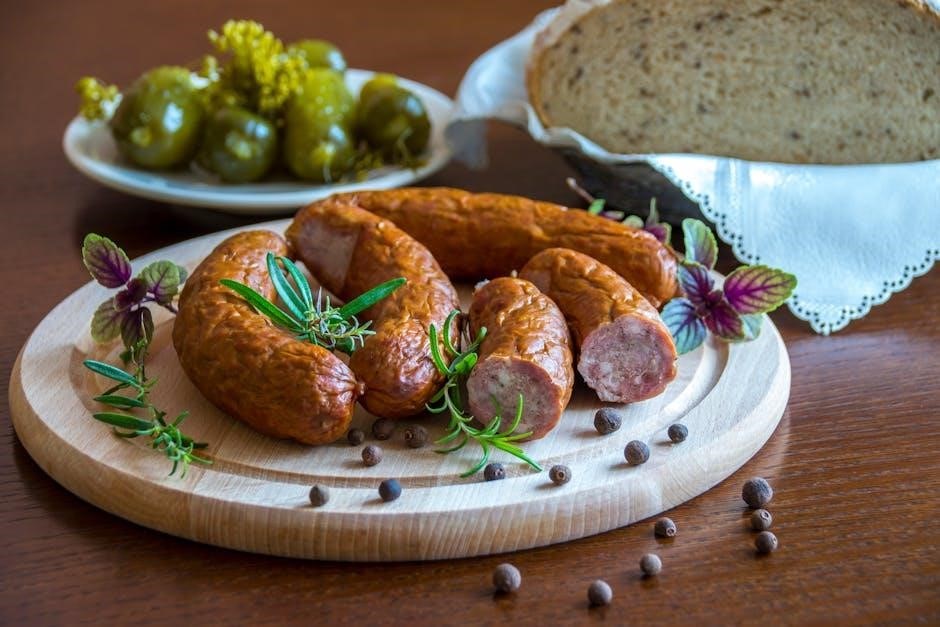Meat smoking charts are a crucial resource for achieving perfectly smoked dishes. They provide detailed temperature, time, and wood guidelines, serving as an essential guide for all skill levels.
Overview of Smoking Charts
Smoking charts are comprehensive guides designed to help both novice and experienced smokers achieve optimal results. These charts typically include detailed information on smoking temperatures, cooking times, and recommended wood types for various meats. They often cover a wide range of meats, including beef, pork, poultry, fish, and game meats, providing specific guidelines for each. Factors such as meat thickness, bone-in or boneless cuts, and fat content are also considered to ensure accurate smoking times. Many charts are available as downloadable PDFs, offering a convenient reference for planning and executing smoking sessions. By following these charts, smokers can ensure safe internal temperatures and avoid over-smoking, resulting in tender, flavorful, and perfectly cooked dishes. They serve as a valuable tool for mastering the art of smoking and experimenting with different techniques and flavors.
Importance of Using a Meat Smoking Chart
Using a meat smoking chart is vital for achieving consistent, delicious results. These charts serve as a quick reference, ensuring smokers can easily find the ideal temperatures and times for their specific meats. They help prevent over-smoking and under-cooking, which can lead to tough or unsafe food. By following the chart, smokers can ensure their meat reaches safe internal temperatures, avoiding health risks. Additionally, charts often include tips on wood selection and managing the BBQ stall, enhancing both flavor and texture. For beginners, they provide a clear roadmap, while experienced smokers can use them to refine their techniques. Overall, a meat smoking chart is an essential tool for mastering the art of smoking, ensuring every dish turns out perfectly tender and flavorful.
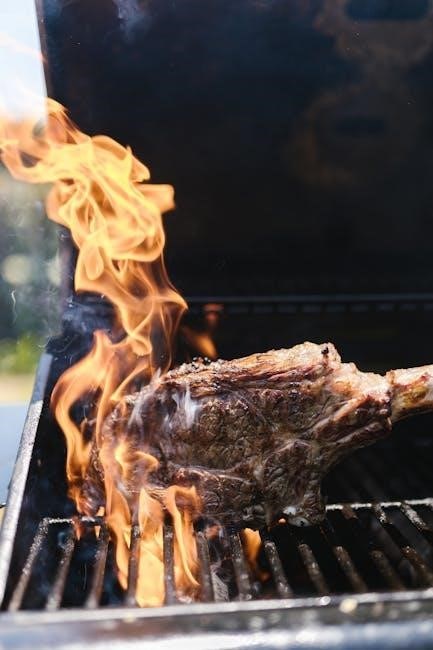
Understanding the Meat Smoking Chart
A meat smoking chart provides a comprehensive guide to temperature, time, and wood pairings, ensuring perfectly smoked results for novices and experts alike. It serves as a clear roadmap for achieving tender, flavorful meats every time.
Key Components of the Chart
The meat smoking chart is designed to simplify the smoking process by organizing essential information into clear categories. It typically includes temperature guidelines, such as smoker temperature and safe internal meat temperatures, to ensure food safety and optimal flavor. Smoking times are provided for various cuts of meat, offering a general estimate for planning. The chart also highlights recommended wood types for different meats, enhancing the overall flavor profile. Additionally, it outlines target temperatures for doneness, which is crucial for achieving tender and juicy results. Some charts may include visual representations or tables for quick reference, making it easier to track progress during the smoking process. These components work together to provide a comprehensive guide for both novice and experienced smokers, helping to avoid common pitfalls like overcooking or underseasoning.
How to Read and Interpret the Chart
Reading and interpreting a meat smoking chart is straightforward once you understand its structure. Start by identifying the type of meat you are smoking, such as beef, pork, poultry, or fish, and locate the corresponding section. The chart will list the recommended smoking temperature and the safe internal temperature for the meat to ensure food safety. Smoking times are provided as estimates, but it’s important to use a meat thermometer to monitor progress, as factors like meat thickness and environmental conditions can affect cooking time. Pay attention to wood pairing suggestions to enhance flavor. Always prioritize internal temperature over time, as this ensures the meat is cooked to a safe and tender level. By following these guidelines, you can achieve consistent, delicious results every time you smoke. The chart serves as a valuable tool for both beginners and experienced smokers.
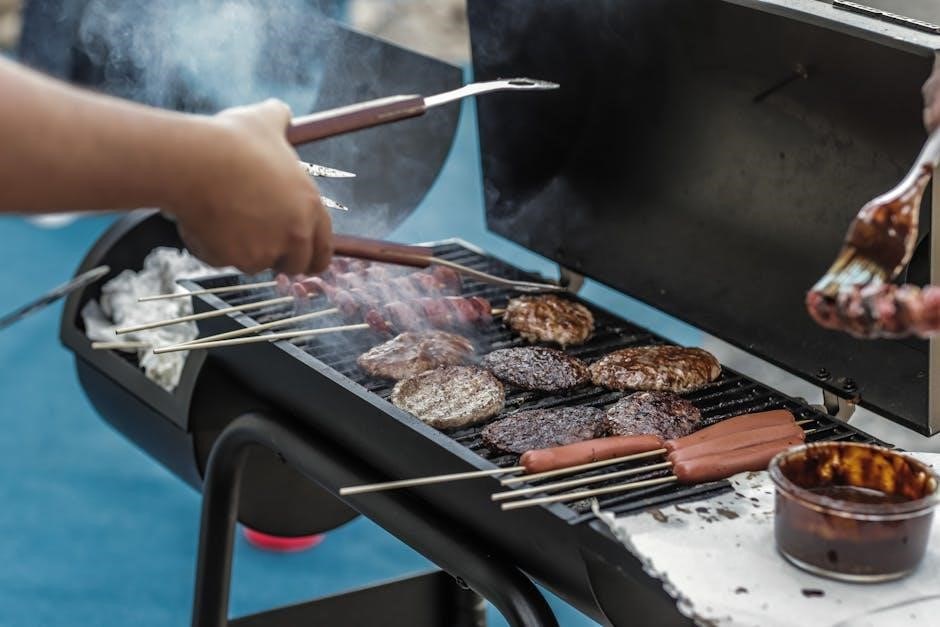
Types of Meats for Smoking
Meat smoking charts cover a variety of meats, including beef, pork, poultry, fish, seafood, and game meats. They provide specific smoking guidelines for popular cuts like brisket, ribs, and poultry, ensuring optimal flavor and safety.
Beef Smoking Guide
Beef is a popular choice for smoking, with popular cuts like brisket, ribs, and tri-tip. Smoking charts provide detailed guidelines for each cut, ensuring tender and flavorful results. For brisket, a temperature of 225-250°F is recommended, with a cooking time of 12-20 hours until it reaches an internal temperature of 190-205°F. Ribs, including beef back ribs and short ribs, typically smoke at 225-250°F for 5-8 hours, reaching 160-170°F internally. Tri-tip is smoked at 225°F for 4-6 hours, aiming for an internal temperature of 130°F for medium-rare. The charts also suggest pairing beef with specific woods like post oak or mesquite for enhanced flavor. Always use a meat thermometer to ensure safety and optimal tenderness, as time is just an estimate, and temperature is the true indicator of doneness.
Pork Smoking Guide
Pork is a versatile and flavorful meat for smoking, with cuts like pork butt, ribs, and whole hams being favorites. Smoking charts offer precise temperature and time guidelines to ensure tender, juicy results. For pork butt, smoke at 225-250°F for 8-12 hours until it reaches an internal temperature of 190-205°F. Pork ribs, such as baby back or spare ribs, smoke at 225-250°F for 5-7 hours, reaching 160-170°F internally. Whole hams are typically smoked at 225°F for 4-6 hours, aiming for an internal temperature of 140°F. The charts also recommend pairing pork with woods like hickory or applewood for rich, smoky flavors. Always use a meat thermometer, as temperature is the most reliable indicator of doneness, and time is just a guideline. Proper smoking ensures safety and delivers mouthwatering, fall-apart pork dishes.
Poultry Smoking Guide
Poultry smoking charts provide essential insights for perfectly smoked chicken, turkey, and other bird meats. Whole chickens smoke at 300°F for 2-3 hours, reaching an internal temperature of 170°F. Chicken breasts smoke at 300-325°F for 1-2 hours, hitting 170-175°F. Turkey legs and wings smoke at 225-250°F for 4-5 hours, aiming for 180°F internally. Safe internal temperatures are crucial, typically 165°F for white meat and 180°F for dark meat. Charts also recommend using maple or cherry wood for a mild, fruity flavor. Always use a meat thermometer, as temperature is the most reliable indicator of doneness. Smoking times are estimates and can vary based on size and thickness. Proper smoking ensures juicy, flavorful poultry dishes while adhering to food safety guidelines. This guide helps both novices and experienced smokers achieve mouthwatering results every time.
Fish and Seafood Smoking Guide
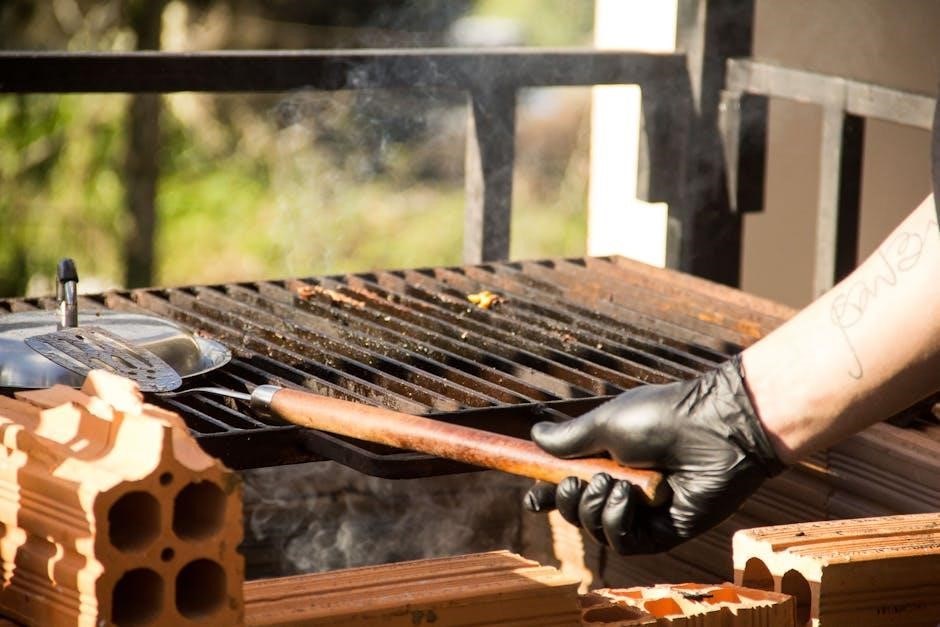
Fish and seafood smoking charts are designed for delicate flavors and textures. Smoking temperatures for fish typically range from 100°F to 200°F, with shorter smoking times to prevent drying. Salmon, trout, and shrimp are popular choices, with smoking times varying from 30 minutes to 4 hours. Internal temperatures should reach 145°F for fish to ensure food safety. Alder and apple woods are recommended for smoking fish, as they add a subtle, sweet flavor. Seafood like mussels or scallops may require even shorter times, typically 1-2 hours. Charts also emphasize the importance of brining or marinating before smoking to enhance flavor and moisture retention. Proper handling and monitoring are key, as fish and seafood can quickly become overcooked. Using a meat thermometer is essential to achieve perfect doneness without compromising texture. This guide helps smokers master the art of preparing delicious, tender fish and seafood dishes.
Game Meats Smoking Guide
Game meats, such as venison, elk, and wild boar, require careful smoking techniques to enhance their rich, bold flavors. Smoking charts provide detailed guidelines for these meats, recommending temperatures between 225°F and 250°F. Smoking times vary depending on the cut and thickness, typically ranging from 4 to 8 hours. Internal temperatures should reach 145°F for medium-rare to ensure food safety. Brining or marinating game meats before smoking is highly recommended to tenderize and infuse flavor. Hardwoods like oak and maple are ideal for smoking game meats, as they complement their robust profiles. The charts also highlight the importance of monitoring meat thickness and fat content, as these factors significantly influence smoking time. Proper handling and storage of game meats before smoking are crucial to maintain quality and safety. Using a meat thermometer is essential to achieve the perfect doneness without overcooking. This guide helps smokers master the art of preparing flavorful and tender game dishes.
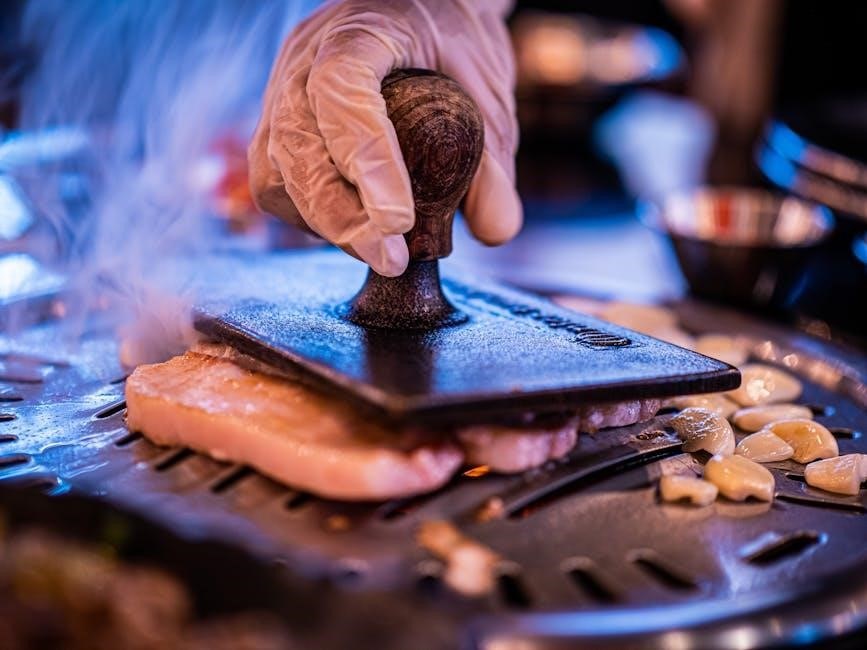
Recommended Smoking Temperatures
Smoking temperatures typically range between 225°F and 250°F, ensuring tender, flavorful results. Lower temps preserve moisture, while higher temps enhance browning and texture in meats like brisket, ribs, and chicken.
Temperature Guidelines for Different Meats
When smoking meats, understanding the ideal temperature ranges is crucial for achieving tender, flavorful results. Beef brisket and ribs typically smoke between 225°F and 250°F, while poultry like chicken and turkey often require slightly higher temperatures, around 250°F to 300°F. Pork, such as pulled pork or pork belly, thrives in the 225°F to 275°F range. For fish and seafood, lower temperatures, 100°F to 200°F, are recommended to prevent overcooking. Always use a meat thermometer to monitor internal temperatures, ensuring food safety. For example, brisket should reach 190°F to 205°F, while chicken breasts need to hit 165°F. Factors like meat thickness, fat content, and bone presence can influence these guidelines, so adjust accordingly for the best results. Consistent temperature control is key to mastering smoked meats.
Safe Internal Temperatures for Cooking
Safe internal temperatures are crucial for ensuring meat is cooked to a safe and enjoyable level. According to USDA guidelines, beef and pork should reach an internal temperature of 145°F (63°C), while poultry needs to be cooked to 165°F (74°C). Fish and seafood typically require 145°F (63°C), and game meats like venison should be cooked to at least 165°F (74°C). Always use a digital probe thermometer to monitor these temperatures accurately. Remember, meeting these temperatures ensures food safety and prevents undercooking. Proper temperature control is essential for a perfect smoke.
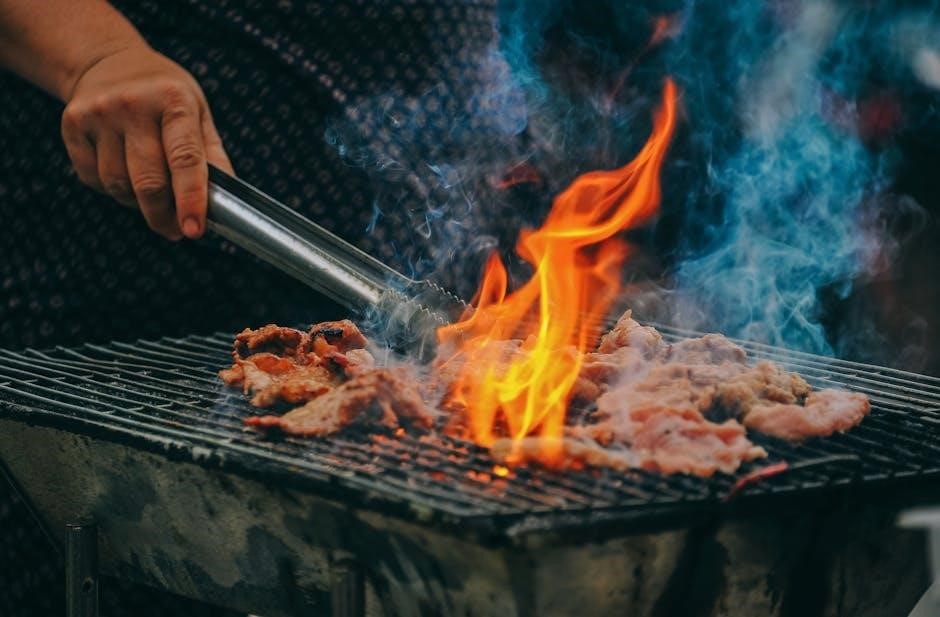
Smoking Times and Estimates
Smoking times vary widely, with brisket requiring 12-20 hours, ribs 3-8 hours, and whole chicken 2-3 hours. Factors like meat thickness and temperature affect duration at specific temperatures.
Estimating Cooking Time for Various Meats
Smoking times vary significantly depending on the type and size of the meat. For example, brisket typically requires 12-20 hours, while ribs can take between 3-8 hours, depending on whether they are baby back, spare, or short ribs. Whole chickens usually smoke for 2-3 hours, while chicken breasts may only need 1-2 hours. Pork butt, a popular choice, often takes 8-12 hours to become tender and flavorful. These estimates are general guidelines, as factors like meat thickness, bone-in or boneless cuts, and fat content can influence cooking time. Additionally, environmental conditions, such as ambient temperature and humidity, play a role. Always use temperature to determine doneness, as time is merely a helpful estimate.
Factors Influencing Smoking Time
Several factors significantly influence smoking time, making it essential to monitor and adjust throughout the process; Meat thickness is a primary factor, with thicker cuts requiring longer smoking times. Bone-in or boneless cuts also play a role, as bones can act as insulators, slowing down cooking. Fat content impacts tenderness and time, with fattier meats often taking longer to become tender. Environmental conditions, such as ambient temperature and humidity, can affect the smoker’s performance and, consequently, the cooking duration. Additionally, the type of smoker and its efficiency can vary, influencing overall smoking time. These variables highlight the importance of using temperature probes and staying attentive to ensure perfectly smoked results. By understanding these factors, smokers can better estimate and manage their cooking times for consistent outcomes.

Wood Selection for Smoking
Choosing the right wood is vital for enhancing flavor; Popular options like hickory, oak, apple, cherry, maple, and mesquite offer unique smoke profiles. Avoid softwoods like pine or cedar for safety and taste.
Best Woods for Smoking
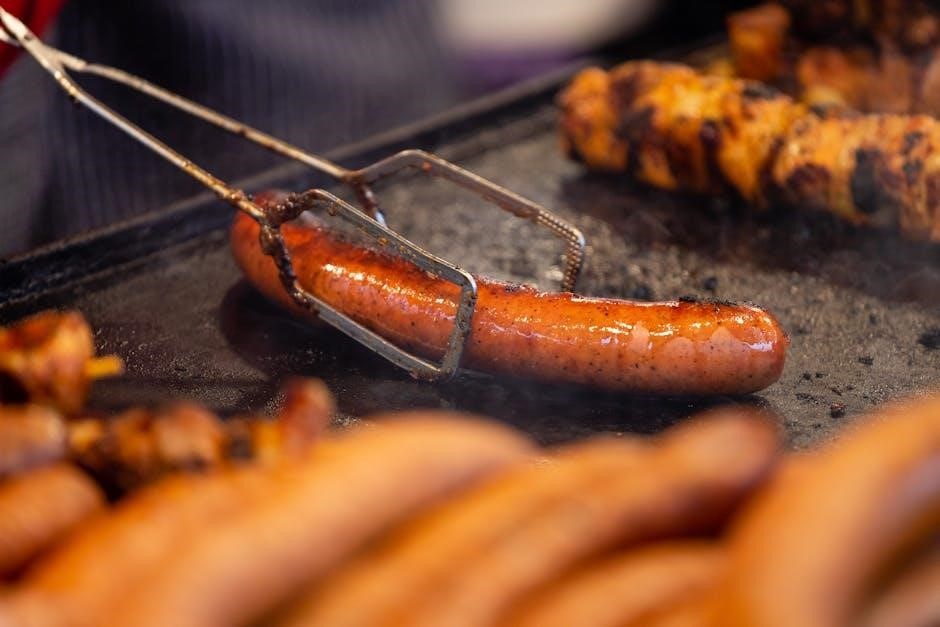
Choosing the right wood for smoking is crucial for achieving rich, complex flavors. Popular options include hickory, oak, apple, cherry, maple, mesquite, and beech, each offering unique smoke profiles. Hickory is a classic choice, providing a strong, savory flavor perfect for bacon and brisket. Oak is versatile, with a mild, smoky taste ideal for beef and lamb. Apple and cherry woods add fruity, sweet notes, pairing well with poultry and pork; Maple is mild and subtle, great for delicate meats like fish or poultry. Mesquite, with its bold, earthy flavor, is excellent for red meats. Beechwood offers a light, slightly nutty smoke, suitable for a variety of meats. Always ensure woods are dry and free of resin to avoid bitter flavors. Avoid softwoods like pine or cedar, as they contain harmful resins. Proper wood selection enhances the overall smoking experience, making it a key element in achieving delicious results.
Wood Pairing with Specific Meats
Pairing the right wood with your meat enhances flavor and texture. For beef, hickory or mesquite are ideal, adding bold, smoky notes to brisket or ribs. Pork pairs well with apple or cherry wood, creating a sweet, tangy flavor profile perfect for tender cuts like pulled pork. Chicken and other poultry benefit from milder woods like apple or maple, ensuring a delicate smoke without overpowering the meat. Fish and seafood are best paired with lighter woods such as alder or beech, preventing the delicate flavors from being overwhelmed. For game meats, stronger woods like mesquite or oak complement their robust flavors. Always consider the meat’s natural taste when selecting wood to ensure a balanced, flavorful result. Proper pairing elevates the smoking experience, making each dish uniquely delicious and memorable. This guide helps you make informed choices for optimal flavor combinations.
Woods to Avoid for Smoking
When smoking, it’s crucial to avoid certain types of wood that can release harmful chemicals or unpleasant flavors. Woods like cedar, cypress, elm, eucalyptus, fir, pine, redwood, sassafras, spruce, and sycamore should never be used for smoking. These woods contain resins or oils that can produce bitter, acidic, or even toxic fumes when burned. Using them can ruin the flavor of your meat and potentially pose health risks. Always opt for hardwoods like hickory, oak, maple, or apple, which are safe and enhance the natural flavors of smoked meats. Proper wood selection ensures a delicious and safe smoking experience. Avoiding harmful woods is a key part of mastering the art of smoking and delivering high-quality results every time. Always verify the type of wood before use to maintain the integrity and safety of your smoked dishes.

Smoking Safety and Tips
Always use a digital probe thermometer to monitor meat temperature for food safety. Proper ventilation and avoiding harmful woods ensure a safe smoking experience. Time is just an estimate—rely on temperature for doneness. Keep the smoker at a stable temperature and monitor wood levels to prevent over-smoking. Always follow safe food handling practices to avoid contamination. Properly store smoked meats in airtight containers to maintain freshness. Preventing the BBQ stall by maintaining consistent temperatures is key for tender results. Never leave the smoker unattended, and ensure it is placed away from flammable materials. Regularly clean and maintain your smoker to prevent residue buildup and ensure optimal performance. Always keep a fire extinguisher nearby for emergencies. Smoking meat requires patience and attention to detail to achieve the best results. Ensure all meats reach safe internal temperatures before serving. Never overcrowd the smoker, as this can lead to uneven cooking and increased risk of contamination. Use food-grade wood only, as treated or painted wood can release harmful chemicals. Always wear protective gloves and eyewear when handling hot equipment or sharp objects. Keep children and pets away from the smoking area to prevent accidents. Properly dispose of ash and wood residue to avoid environmental hazards. Regularly check the smoker’s temperature and adjust as needed to maintain a consistent cooking environment. Never smoke in enclosed spaces without proper ventilation, as this can lead to carbon monoxide buildup. Always follow the manufacturer’s instructions for your specific smoker model. Familiarize yourself with local fire safety regulations before smoking. Keep a first aid kit nearby in case of burns or other injuries. Always use tongs or spatulas to handle meat, avoiding direct contact with hot surfaces. Never smoke meat that has been left at room temperature for too long, as this can promote bacterial growth. Always defrost meats properly before smoking to ensure even cooking. Prevent cross-contamination by using separate utensils and plates for raw and cooked meats. Smoking meat is an art that requires attention to safety to enjoy delicious and healthy results. By following these tips, you can ensure a safe and enjoyable smoking experience for yourself and your guests.
Food Safety Guidelines

Food safety is paramount when smoking meat. Always use a digital probe thermometer to ensure meats reach safe internal temperatures, as outlined in the meat smoking chart PDF. Never smoke meat that has been left at room temperature for too long, as this can promote bacterial growth. Properly defrost meats before smoking to ensure even cooking. Prevent cross-contamination by using separate utensils and plates for raw and cooked meats. Store smoked meats in airtight, vacuum-sealed containers to maintain freshness and prevent spoilage. Refrigerate or freeze smoked meats promptly after cooking. When reheating, ensure meats reach a minimum of 165°F (74°C) to avoid foodborne illness. Avoid smoking in enclosed spaces without proper ventilation to prevent carbon monoxide buildup. Always follow safe food handling practices to enjoy delicious and healthy smoked dishes. These guidelines ensure a safe and enjoyable smoking experience.
Preventing Over-Smoking
Preventing over-smoking is essential to achieve tender, flavorful meats. Over-smoking can lead to dry, bitter, or overly intense flavors. To avoid this, monitor the smoking time and temperature closely, as outlined in the meat smoking chart PDF. Use a digital thermometer to track internal meat temperatures accurately. Avoid smoking for extended periods beyond the recommended time for your specific cut of meat. Wrapping meats in foil during the later stages of smoking can help prevent over-smoking and retain moisture. Choose the right type of wood, as some varieties, like mesquite, can overpower the meat if used excessively. Ensure proper air circulation in your smoker to avoid concentrated smoke buildup. Resting the meat after smoking allows juices to redistribute, further enhancing flavor and texture. By balancing time, temperature, and wood, you can prevent over-smoking and achieve perfectly cooked, delicious results every time.
Managing the BBQ Stall
The BBQ stall is a common challenge during meat smoking, where the internal temperature of the meat appears to stop rising for a period. This typically occurs between 150°F and 170°F. To manage the stall, it’s crucial to maintain consistent smoker temperatures and monitor the meat closely. Wrapping the meat in foil during this phase can help overcome the stall by retaining heat and moisture. Using a water pan in your smoker can also aid in maintaining humidity, which helps prevent the meat from drying out. Allowing the meat to rest after smoking is another effective strategy, as it enables juices to redistribute, resulting in a more tender and flavorful final product. Proper management of the BBQ stall ensures your smoked meats remain juicy and full of flavor, avoiding the risk of overcooking or drying out.
